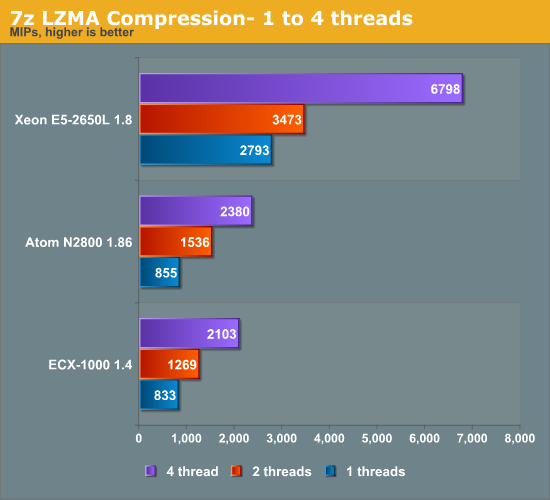Server Update April 2013: Positioning the HP Moonshot 1500
by Johan De Gelas on April 11, 2013 8:11 AM EST- Posted in
- Enterprise CPUs
- Arm
- Xeon
- Enterprise
- Calxeda
- S1200
Our First Impressions
So how attractive is HP's Moonshot 1500 system chassis? HP claims that for the right workloads, these systems will be 77% less costly, consume 89% less energy, take 80% less space and be 97% less complex. HP bases this on a comparison of one of its own proprietary 47U (non-industry standard thus) Moonshot racks with 5 racks of traditional 1U, 2 socket servers. That is a server form factor which was very popular in the beginning of this century. For some reason, some of the PR people at HP have missed the launch of HP's blade servers in 2002, have never heard about the Twin(²) designs of Supermicro and also conveniently forgot about the fact that we now fill up our 2U and 3U boxes with memory, install a hypervisor on top of it and run a few tens of virtual machines upon it.
We have serious doubts that the current implementation will offer a significantly higher performance per watt ratio than the current low power server options, even when running the "right" workloads such as web front serving, content delivery (mostly photos and images) and memcached servers. Our doubts are based upon several datapoints.
Firstly, the performance per watt of the current Atom S1260. At 2GHz, it is clocked 7.5% higher than the Atom N2800 1.86GHz we tested. That clockspeed advantage is about the only advantage it has over the N2800, so we expect it to perform up to 7.5% better but not more. The advantage of using 1333 MHz instead of 1066 MHz DDR3 is probably very small and partly negated by the fact that ECC takes a bit of performance away. Therefore, we can get an idea how the individual Moonshot server Catridge will perform.
Take a look at the compression benchmark below. Compression is a low IPC workload that's sensitive to memory parallelism and latency. The instruction mix is a bit different, but this kind of workload is still somewhat similar to many server workloads.

You can easily calculate where the Atom S1260 would land. Add about 8% to the scores of the Atom N2800. Extrapolating these number, we may expect the Atom S1260 to score 2570 at the most. That is about 22% better than the ARM Cortex A9 based quad core of Calxeda at 1.4GHz. Single threaded performance would be less than 10% better.
If you consider the TDP of this chip, the age of the Atom core is really showing. The heavily integrated ECX-1000 SoC - 4 cores, management, networking and IO controllers - needs about 5W at the most (at 1.4GHz, 3.8W at 1.1GHz). The Atom S1260 needs 8.5W and that does not include its network and management chips. So we estimate that the current Atom S1260 probably needs twice as much power to offer the 20% performance advantage illustrated above.
There is more...










26 Comments
View All Comments
pixelstuff - Thursday, April 11, 2013 - link
The acronyms were quite prolific in this article.WeaselITB - Thursday, April 11, 2013 - link
IDK, TLAs R AOK w/me.mayankleoboy1 - Thursday, April 11, 2013 - link
AFAIk, LZMA uses only two threads...LZMA2 can use as many as required. Can you do another benchmark, this time with LZMA2 algo, and set the number of threads to something big.
mayankleoboy1 - Thursday, April 11, 2013 - link
Nevermind, i thought you were testing on the complete thing, not only one node.JohanAnandtech - Thursday, April 11, 2013 - link
The benchmark actually spawns 4 threads if you instruct it to do that.mayankleoboy1 - Thursday, April 11, 2013 - link
Those 4 threads would be 4 processes, right ? Or a single process with 4 threads ?Kevin G - Thursday, April 11, 2013 - link
Any news of Intel's ISCCC coming to market? Even if performance is the same, it further integrates the various nodes further for greater density and the possibility of lower performance.Gigaplex - Thursday, April 11, 2013 - link
I wonder how AMDs Bobcat would compare in this scenario.Spunjji - Friday, April 12, 2013 - link
Probably average, not great at anything though as its PPW is probably lower than ARM in this scenario. That's mostly due to outdated process tech, though, so Jaguar might well be a nice competitor; even more so if people can figure out novel ways to use the GPU.fteoath64 - Wednesday, April 17, 2013 - link
The Atom is between a rock-and-a-hard-place. It is only good for consumer NAS devices and nothing really else. The Bobcat cores are worse in power consumption while 25% SLOWER than the Atom , so it is pretty useless, although its gpu is rather respectable at 80 cores. The low power Xeon Haswell is rather nice and should be developed (or sliced and diced) into the "New" Atom2 architecture, saving Intel the dearth of the Atom brand that has long since been dead and beaten over and over. There is no shame for Intel on this "dead horse". they kept beating it for all to see!.